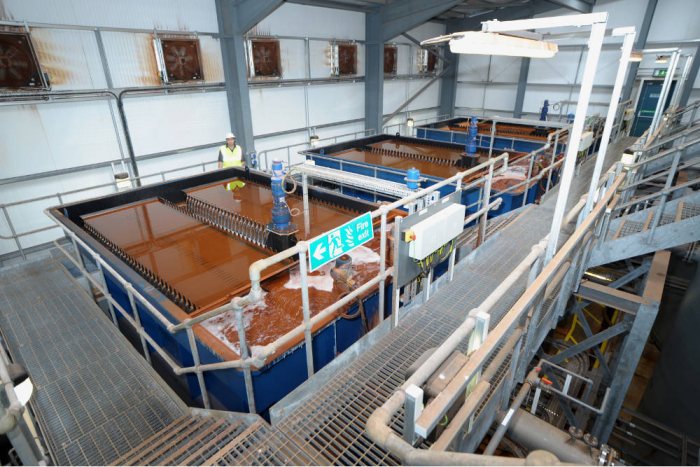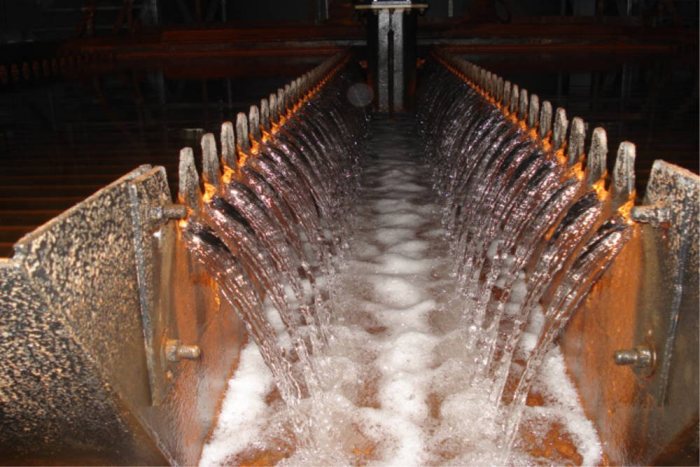
Coal’s legacy – more than emissions | Image: Coal Authority
Solar electricity isn’t just preventing new damage from burning coal, it’s also helping to deal with the legacy left from abandoned coal mining operations in the UK.
During the course of mining, water seeping into or collecting in a mine is pumped out. Once it is abandoned and the pumps switched off, this water can accumulate. Iron within the rocks mixes with the water and as this comes to the surface and is exposed to air, a reaction takes place making the water acidic.
Even in coalfields with high levels of limestone that counterbalance the acidity, the small particles of iron precipitate as ochre, which can pollute waterways. Water from these mines can also have high levels of other toxins and dissolved salts, with chloride concentrations around double that of sea water.
Its’ not a small problem – the drinking water of tens of thousands of people is threatened by the issue.
75 Troublesome Mine Sites
Prior to late 1999, metal and coal mine operators in the UK could just walk away from a mine without addressing the ongoing threat of contamination to waterways and aquifers. That responsibility has fallen to the Coal Authority and the Environment Agency, which has been saddled with the task of staying on top of the issue at more than 75 sites.
While passive approaches to treatment such as phytoremediation (using plants including reeds) in wetlands are favoured, Active treatment involving pumping and chemicals are used as a short-term solution or when the substantial area required for passive schemes isn’t available.
Pumping and treating the polluted water and other remedial action has been an energy intensive and expensive task – it’s a £2.8 billion long-term mining legacy.
Solar – Cost-Effective And Efficient
Early last year, 192 solar panels were installed on the roof of the main building at the Dawdon treatment scheme as a trial, with the electricity being used to reduce expenses associated with pumping mine water on site. The trial was a success, with the Coal Authority determining solar power was a cost-effective and efficient strategy.

Dawdon Treatment Scheme – Coal Authority UK
A tender process to roll out solar across all 75 sites was then announced and work is nearing completion on the first round, with a second release of sites about to have PV arrays installed. Among the successful companies in the tender bid was HBS New Energies.
“This large-scale solar PV programme is a clear sign of the authority’s future intentions as they look to increase their on-site renewable energy generation,” said HBS’s Business Development Director, Stuart Gentry. “The deployment of solar power will help the Coal Authority to meet its aim of off-setting the costs of managing water treatment on site, whilst enhancing their sustainable operations.”
Solar power can’t always contribute a solution to the damage caused by coal mining, but it can help address it in other ways. For example, we recently mentioned a 40MW floating solar farm has been constructed in China on what would otherwise be an area rendered useless by coal mining activities.
Coal – A Long History And No Future
Coal mining in the United Kingdom goes back to Roman times and peaked in 1913.
While the legacy of old coal mines will haunt the Coal Authority (and taxpayers) for years to come – thankfully there shouldn’t be any new ones to deal with. This isn’t just due to tighter environmental regulations, but also because deep pit coal mining ended in the UK in 2015.
In another sign of the times, Britain went a full day without using coal power to generate electricity in April this year – the first time this has happened since the Industrial Revolution. Britain’s last coal power plant is scheduled to close by 2025.
Solar energy is making great progress in generating electricity that coal once did. Recent statistics indicate 916,800 solar installations are in place across the UK, collectively representing 12.3GW of renewable energy capacity.

 RSS - Posts
RSS - Posts



Very well said. Using Solar PV panels are helping to save the cost of electricity especially when they do an operation inside of mine site.